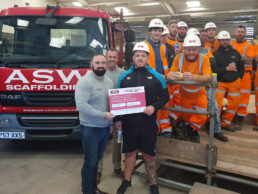How to take a good press shot

A step by step guide to picture-perfect press images
It’s often said that a picture can paint a thousand words and that’s indeed true if there’s time to stand and stare. In the context of press photography however, this visual prompt needs to tell a story in a hundred words. It must be immediately obvious as to the who, the what and the why.
What is a press shot?
Flick through a newspaper or magazine or scroll on a phone and our eyes are naturally drawn to a picture complete with caption. These images encourage us to read on, to find out more whilst adding colour and interest to an otherwise word heavy page.
Any PR who practiced before the noughties will remember booking and budgeting for specialist photographers. They would turn up with impressive SLR cameras and work wth us as we directed a shoot, whether for a product launch or a group of anxious new members of staff.
As my blog PR and Advertising. What’s changed in 30 years? mentions, the PR would select the best shot, post it with a hard copy of the press release in the hope that the picture would appear on the pages of a target publication, large and loud. And so the job of the PR was done.
Fast forward to the era of the smart phone and an image-led culture and we can be our own press photographers, but only if we know what we are doing.
Do you need one?
Before you start, ask yourself if the story warrants a picture and if it will add anything to the overall messaging. A prizegiving or launch event as well as new appointments are a ‘yes’ but if results of a survey or you’re announcing financial figures then it might not be a requirement.
Press shot etiquette
By following a few simple rules, it’s possible to create good press photographs, increasing your chances of an editor choosing to run your image alongside a press release.
- Common mistakes – having too many people in the shot, all lined up in an uninteresting way and where faces are small and expressions can’t be seen.
- Introducing a prop – it adds interest and gives the subjects something to do with their hands and is a focus for the shot and helps to tell the story.
- Make it landscape– orientation matters and landscape (meaning horizontal) is preferable as when the image is used online, it can fill the width of a screen.
- Count your pixels – to increase your chances of your image being used in print and online, your camera needs to capture images in high enough resolution, so at least 300 pixels per inch (ppi) aka dots per inch (dpi).
But if your client budget allows, professional press photographers are pros for a reason. For a few hours of their time, you’re guaranteed great composition and images that are fit for purpose, no matter the channel. If not, then happy snapping – it’s easy-ish when you know how.